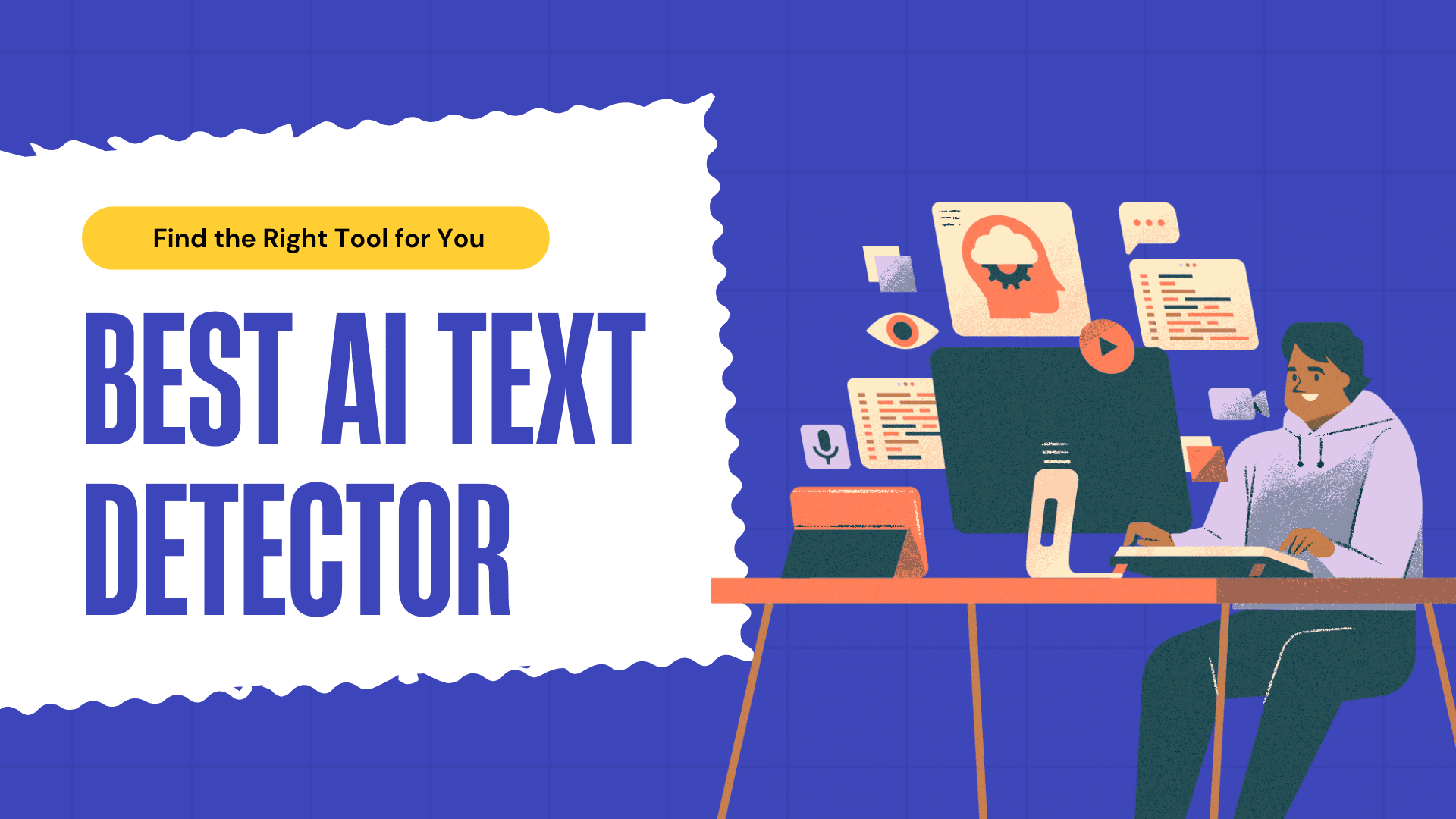Top 6 Picks (Quick List)
Got it — here’s the quick list of only the tools you’ve covered:
AISEO AI Detector — Free detector with highlight → humanize workflow; pay-as-you-go fixes.
Humanize AI — Detects and rewrites flagged passages to a natural human tone; free detection, pay-as-you-go humanization.
GPTZero — Academic favorite; granular sentence-level flags; strong for essays and classrooms.
QuillBot AI Detector — Writer-friendly, fast results inside a full editing suite (paraphrase, grammar, citations).
Copyleaks — Enterprise-grade AI + plagiarism checks; APIs, LMS integrations, compliance focus.
Originality.AI — Publisher/SEO focus; site scans, team dashboards, Google Docs writing replay.
Top AI Detectors Comparison Table

Introduction
AI writing has become impossible to ignore — and even harder to detect. Every day, millions of articles, essays, and business documents are quietly shaped by tools like ChatGPT, Gemini, Claude, and DeepSeek. Sometimes that’s a productivity win… but other times, it threatens credibility, academic integrity, and even search rankings.
That’s why AI detection has become the new gatekeeper of trust.
From universities cracking down on fully automated essays to brands losing traffic because Google flags “robotic” content, the stakes have never been higher. A paragraph that looks perfectly normal can get flagged, penalized, or questioned — and once that doubt appears, it’s hard to erase.
But here’s the good news: the best AI text detectors today don’t just point fingers. They help you verify authenticity, protect your brand voice, and fix what needs fixing before it becomes a problem.
In this guide, you’ll find the most reliable AI detection tools right now — tested, compared, and broken down by real-world use cases. Whether you’re publishing daily, submitting to your professor tomorrow, or auditing a site that depends on rankings, there’s a detector here built for exactly your situation.
The Best AI Text Detector Tools That Can Tell the Difference
We tested and reviewed the best AI text detector tools available in 2025 to see which ones truly identify machine-generated writing and protect authenticity. Below is our expert-curated list of the top options — and who each one is best for.
1. AISEO AI Detector
AISEO approaches detection from a publisher’s perspective: it’s built to protect rankings, brand credibility, and reader trust, not to police classrooms. Unlike many detectors that end with a red flag, AISEO’s workflow goes further—detect → highlight → humanize—so you can repair risky sections immediately and ship content that reads naturally. That “fix loop” is what distinguishes AISEO from academic-first tools.

What it does (in plain English)
- Scans pasted text, files, or URLs and returns a detection score, plus highlights where AI-like patterns show up (e.g., overly predictable phrasing, repetitive structure). AISEO
- Puts those highlights one click away from Humanize, AISEO’s rewrite feature designed to restore natural variation and voice while preserving meaning and SEO intent. AISEO+1
- Supports multiple languages so global teams can evaluate and revise content across markets.

In other words, AISEO is a content governance loop: identify robotic copy, fix it fast, re-scan, then publish.
Why it stands out
1. SEO-aware mindset. The tool and its surrounding suite (Outrank, Site Audit, Brand Monitor) are built around search performance and authenticity, not just statistical detection. If you care about Google’s Helpful Content standards and avoiding “AI-sounding” pages, this orientation matters. AISEO
2. Immediate remediation. You don’t have to guess how to fix flagged text. Hit Humanize and get a cleaner, more varied rewrite that you can tweak to your brand tone, then re-scan to confirm. This keeps editorial pipelines moving.

3. Practical at scale. Bulk/document/URL scanning plus multi-language support make it usable for agencies and enterprise teams auditing back catalogs or multi-author programs.
4. Business-first positioning. AISEO is designed for marketers, publishers, e-commerce, and media—places where throughput and quality control are paramount—rather than academic evidence chains.
Where it’s strong (real-world use)
- Mixed human + AI drafts. Many detectors get fuzzy when content is partially human-edited. AISEO’s per-section highlights make it easier to localize the issue and repair only what’s needed. AISEO
- Editorial speed. Turnaround is fast; scanning and fixing fits naturally between revision passes. AISEO
- Global teams. Multilingual detection + humanization helps keep tone and authenticity consistent across locales. AISEO
Pricing
AISEO uses a pay-as-you-go system rather than recurring billing. Credits are only required after AI content is detected and the user decides to humanize or further optimize the text.
- Free AI detection with character caps
- Pay only when deeper revisions are needed
- Credits never go to waste — you control usage
- Business-friendly for agencies auditing large sites
This approach allows you to verify content authenticity without committing to monthly expenses — and only invest when content requires improvements.

Practical advice on how to get reliable outcomes
- Scan early in the edit. Don’t wait until it’s in the CMS. Earlier scans reveal robotic sections before they ripple through the piece. Re-run detection after each significant pass.
- Work in sections. Analyze intro, body blocks, conclusion separately. Fix what’s flagged, then re-scan the whole draft. This isolates problems and reduces over-editing.
- Use Humanize surgically. Rewrite only flagged paragraphs; leave authentic human sections intact to preserve author voice. Then do a quick brand-tone pass (terminology, power words, sentence rhythm).
- Keep your SEO payload. If you’re optimizing for queries, ensure the rewritten text retains intent and key entities. AISEO’s ecosystem is designed to help, but you’re still the editor in charge of ranking signals.
- Cross-check high-stakes content. For campaigns or core pages, validate with a second detector to reduce edge-case false positives/negatives.
Audit your back catalog quarterly. Legacy AI-assisted posts can quietly depress site quality signals. Run a URL batch, fix outliers, and watch engagement/visibility lift.
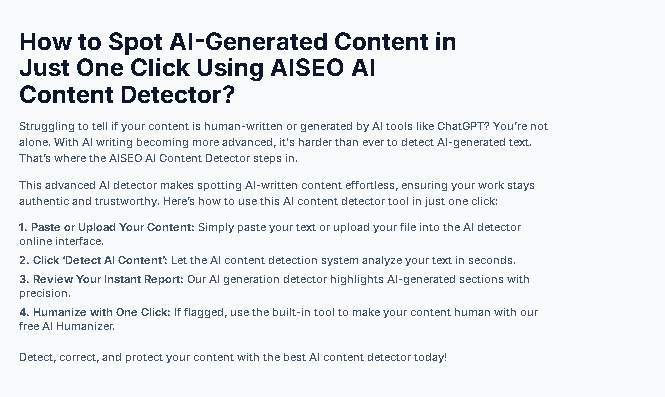
Best fit
- SEO/content teams publishing frequently and protecting rankings
- Agencies & publishers who need to triage, repair, and approve quickly
- E-commerce & SaaS maintaining brand credibility at scale
Global brands needing multilingual detection + repair AISEO

2. Humanize AI
Humanize AI Detector is a tool designed for the era where AI-written content is everywhere — and so are AI detectors. What sets this tool apart is that its goal isn’t just to identify AI writing. It is built to fix it. Humanize AI helps you keep your content original, emotionally engaging, and undetectable — whether you're writing for SEO, school, or branded communication.
It has quickly become a go-to solution for creators who want the best of both worlds: speed from AI writing tools and the credibility of natural human language.

Key Features
1. Advanced Multi-Model AI Detection
Humanize AI detects content written by major LLMs including ChatGPT, Gemini, Claude, Grok, DeepSeek, LLaMA and more. It analyzes probability patterns, logical flow, and linguistic predictability — the same signals AI detectors look for. Result: You get a clear visibility score showing where your content risks detection.

2. Detector Matching Engine Humanize AI is trained against the same detection mechanisms used by top tools like: • Originality.AI • GPTZero • Copyleaks This means it doesn’t just detect AI — it can predict whether other platforms will detect it too.

3. Long-Form AI Scan Support Up to 15,000 characters per scan — ideal for blog posts, school papers, and marketing content. Most free AI detectors cap at just 2–3 paragraphs.
4. Multi-Language AI Detection It supports AI detection in 30+ global languages, not just English. Students and global brands get accurate results regardless of their language.

5. Confidence-Based AI Scoring Instead of a vague “AI likely,” Humanize AI provides: • How much AI content is detected • How confident the algorithm is This improves decision-making before publishing or submitting the content.
Practical Guide: How to Use Humanize AI Effectively
- Paste or upload your text into the AI detector
- Run a scan to see which parts seem AI-generated
- Copy the phrases or words marked red and paste them on the Humanize AI Text tool
- Read through and adjust personal tone if needed
- Run one more AI check before publishing or submitting
Tip: Work in chunked sections for realistic variation in style and flow.

Pricing
One of the biggest advantages of Humanize AI by AISEO is that users can access AI detection completely free. There’s no account required to run a scan, making it highly accessible for students, writers, agencies, and publishers who want instant verification without subscriptions or limitations.
However, if you identify AI-generated content in your scan, Humanize AI offers a pay-as-you-go model to convert flagged sections into natural human-sounding text. Instead of locking you into expensive monthly plans like other platforms, AISEO only charges when you choose to humanize content — a far more budget-friendly option for teams and individuals who publish content regularly but don’t require constant rewriting.

Best Use Cases
• Writers ensuring content feels genuine and audience-focused
• SEO teams protecting against Google’s helpful-content enforcement
• Students validating originality before submission
• Brands refining tone consistency
• Businesses avoiding AI-flagged documentation
Humanize AI is especially suited for those blending both human writing and AI drafting in their workflow.

3. GPTZero
GPTZero was developed by Edward Tian (a Princeton graduate) to help educators and institutions identify text generated by large language models (LLMs). What began in academia has matured into a commercially-available tool, used in education, publishing and business settings.

It claims to detect content from major AI models (e.g., ChatGPT, Gemini, Claude, LLaMA) using a multi-step model.
Why It Stands Out
Focused on authenticity: Its evolution from academic use gives it credibility with educators and institutions. Detailed detection metrics: It uses sentence-level analysis so you can see exactly which parts of the text are flagged as likely AI-generated. Broad integration & workflow support:
- Upload full documents (PDF, Word) or batches of files—helpful for classrooms/enterprises.
- Integrates with Google Docs, Chrome extension, LMS platforms (Canvas, Moodle) allowing detection in situ rather than only via copy-paste. High claimed accuracy: According to GPTZero’s own site, their model reaches ~99% accuracy in certain scenarios. Additional writing-quality tools: Beyond simply detecting AI content, GPTZero offers features like “AI Vocabulary” (highlighting over-used machine-style words), writing feedback, and plagiarism/source-checking so you’re not only verifying authenticity but improving content.
Key Features & Capabilities
- Human vs. AI probability scoring: Displays a percentage (or score) showing likelihood of AI generation.
- Sentence- or section-level highlighting: Allows reviewers to identify specific sentences flagged as AI-generated.
- Document upload / batch processing: Supports full files rather than just pasted text—useful for academic submission or bulk checking.
- Browser and editor integrations: Chrome extension, Google Docs add-on for on-the-fly detection.
- API & enterprise support: For organisations needing to integrate detection into their workflows or LMS.
- Writing feedback & quality tools: Includes tools to improve text (reduce AI-like vocabulary, improve readability, check citations).
- Plagiarism/source detection add-ons: Ensure originality in addition to authorship authenticity.
- Support for multiple major AI models: Designed to detect not only older models but also some newer ones (e.g., Gemini, LLaMA) and mixed-authored content (human + AI).
Integration in educational workflows: Especially useful in verifying student work, maintaining academic integrity, monitoring AI usage across institutions.

Limitations & What to Be Careful Of
- While accuracy is high for certain inputs, no detector is perfect. Deeply edited or heavily humanised AI-generated text may evade detection or yield ambiguous results.
- It may mis-flag formal, polished human writing as AI (false positives) especially when sentence structure is highly regular or lacks “burstiness” (variation) that the detector expects.
- Some features/feedback may feel oriented more toward academic settings (essays, student submissions) rather than pure marketing or business content workflows.
- Short text samples are inherently harder to classify reliably; performance improves with longer documents and richer context.
- For maximum value, you’ll likely need a paid plan (especially if you’re processing large volume or batches) — the free tier may be limited in usage.
Pricing & Plans
Here are typical pricing tiers based on current publicly available info (always check vendor directly for latest).
- Free / Basic Tier: Allows entry-level access (e.g., thousands of words per month). For example one source lists ~10,000 words/month free.
- Essential: Approx US $8.33/month (which annual-billed works out lower) for ~150,000 words/month.
- Premium: Around US $12.99/month (annual billing) or US $14.99 (monthly) for ~300,000 words/month and extras like writing-feedback and plagiarism scan.
Professional / Team / Enterprise: Approx US $24.99–45.99/month or more depending on volume (500,000+ words/month, batch uploads, team features, file-by-file scanning, enterprise-grade security/integrations).

Best For & Use-Cases
- Education / academia: Teachers, professors and institutions verifying student papers, research submissions, class assignments—especially where blocking or controlling AI usage matters.
- Publishing / content authenticity: Editors, publishers ensuring articles, white-papers or marketing content are genuinely human-authored, or tracking human/AI hybrid contributions.
- Enterprise / compliance: Organisations that require the verification of authored text (legal reports, internal documentation, professional writing) for authenticity, brand safety or regulatory reasons.
- Workflow integration: If you’re looking to embed AI-detection into an LMS, workflow tool, or content pipeline (API, Chrome extension, batch uploads) GPTZero offers capabilities to scale.
- Improve quality of writing: Beyond detection, if you want feedback on writing style, avoid AI-like phrasing, refine readability and tone, GPTZero’s extra tools make it more than a simple detector.

4. QuillBot AI Detector
QuillBot’s AI Detector is part of the broader QuillBot writing-suite that combines paraphrasing, grammar-checking, translation, summarising and more. It’s aimed at writers, students, educators and professionals who want not only to check for AI-generated text, but also to refine their writing and maintain authenticity.
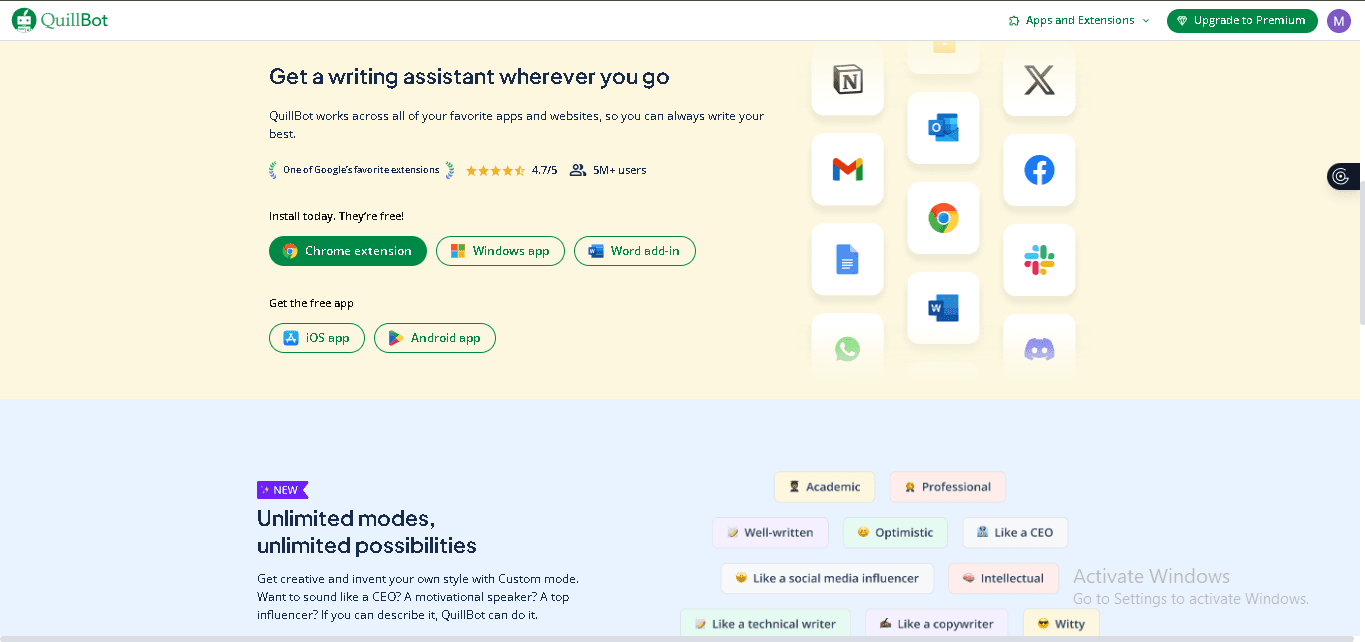
Why Use It / What Makes It Stand Out
• Integrated writing-tool ecosystem: Unlike standalone detectors, QuillBot places the detection capability within a full writing toolset (paraphraser, grammar check, citation generator, translator, etc.). This makes it convenient if you’re already editing or polishing content.
• Ease of use & accessibility: The detector is usable via a clean interface, supports multiple languages, and allows quick scanning of text—even from within the same platform you’re writing in.
• Transparent scoring: You’ll receive a breakdown of likelihoods (“AI-generated”, “Human-written & AI-refined”, “Human-written”) plus highlighted segments that appear suspicious, which aids review and revision.
• Affordability & flexibility: There’s a free tier for basic use, plus premium pricing that’s competitive relative to other tools—making it accessible for individual users, students or smaller teams.
• Multilingual support: The detector supports multiple languages (English, French, German, Spanish) making it relevant for multilingual content creators.

Key Features & Capabilities
- Paste or upload text: You can enter text manually or upload documents, then scan for AI-content. (Note: preferentially longer texts give more reliable results.)
- Probability scoring: Provides percentages or scores indicating how likely the text is AI-generated vs human-written vs human-written & AI-refined.
- Line- or sentence-level insights: Highlights specific sentences or sections that show AI-patterns (repetitive language, low variation, overly formulaic).
- Writing improvement tools: The same platform allows you to revise highlighted sections—using paraphrasing, grammar suggestions, “humanise” modes—to adjust text that may appear too AI-like.
- Multiple language detection & support: Useful when your content spans different languages.
- Downloadable reports (in some plans): Some usage scenarios allow you to export a PDF report of detection results for record-keeping or review.
- Integration within the writing workflow: Because it’s part of a tool that writers already use for editing, it smoothly fits into content creation rather than being a separate step.
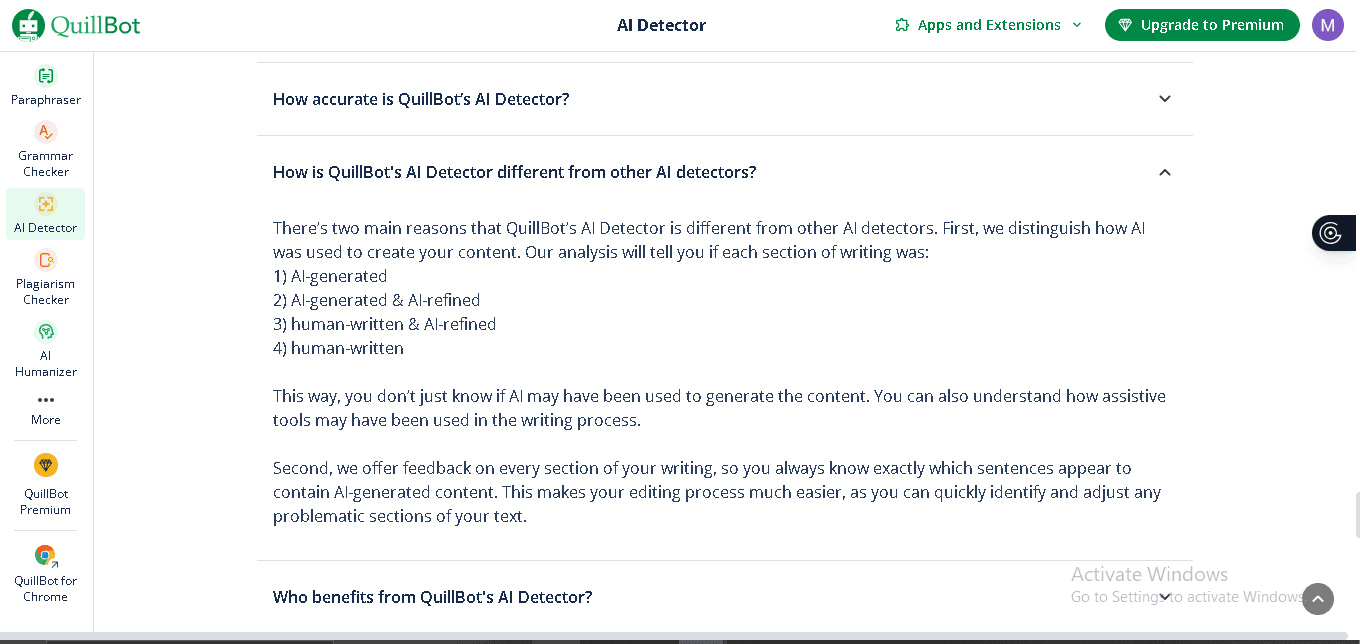
Limitations & Important Considerations
- Detection accuracy isn’t flawless: Some independent reviews suggest the accuracy is about ~80% in certain tests for fully AI-generated text.
- Edited or hybrid texts are harder: If AI-generated text has been heavily edited or human-refined, the detector may struggle to flag it reliably.
- Short text samples pose challenges: Detectors generally perform better with longer texts; very short passages may yield ambiguous or less reliable results.
- Not solely a detector tool: Because it’s integrated with a broader suite, it may lack some of the advanced detection-specific analytics or enterprise-grade features found in dedicated detection platforms.
- Results should be reviewed: The tool itself emphasises that detection results are a signal—not a definitive judgement. You should still apply human review and context understanding.

Pricing & Plans (2025 Snapshot)
- Free Plan: QuillBot offers a free version with basic access to the AI Detector (limited word-count/usage) and its other writing tools. AI Detect Plus+1
- Premium Plan: Starts at approximately US $8.33/month when billed annually (≈US $99.95/year) and includes unlimited paraphrasing, unlimited AI-Detector usage (within the plan limits), grammar and writing feedback, and the full writing suite.
- Monthly Billing Option: If you prefer monthly billing rather than annual, the cost is moderately higher (e.g., ~US $19.95/month) for full access.
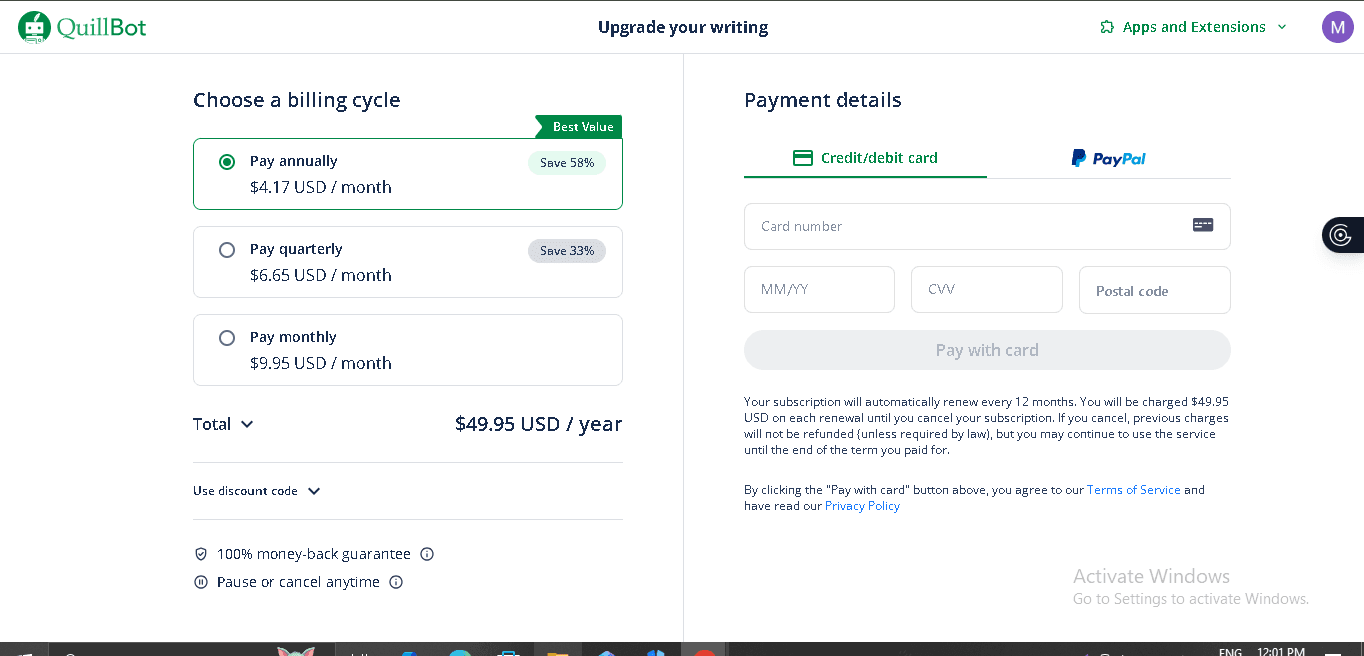
- Team / Organization Plan: For multiple users/teams, QuillBot offers a “Team Plan” with user-management, usage analytics, centralized billing. Pricing varies by number of users.

Why You Should Use It
- You’re a content creator, student or editor and you want a single platform where you can both check for AI-generated text and improve the writing (rather than just detect).
- You value ease of workflow, meaning you don’t want to switch between many tools; using QuillBot means detection, rewriting and refinement happen in one place.
- You’re working in multiple languages or in multilingual contexts, and need detector support beyond English.
- You want an affordable solution for moderate usage (e.g., blog posts, essays, content editing) rather than a high-volume enterprise setup.
- You want the flexibility to not only detect AI patterns but also address them proactively (for example, ensuring content “feels human” and avoids algorithmic tone).
4. Copyleaks AI Detector
Copyleaks is a robust content-integrity platform designed to detect AI-generated text, check plagiarism, monitor image manipulation, and enforce governance over sanctioned vs unsanctioned AI usage. It’s used by educational institutions, publishers, corporate compliance teams, and content marketing organizations.

Why It Stands Out
1. Enterprise-level credibility & security
- Copyleaks claims over 99% accuracy in detecting AI-generated text and reports a false-positive rate as low as 0.2%.
- Certifications include SOC 2, SOC 3, GDPR compliance—important when student or sensitive corporate data is involved.
- Used across global enterprises and education systems for authenticity, compliance and workflow integrations.
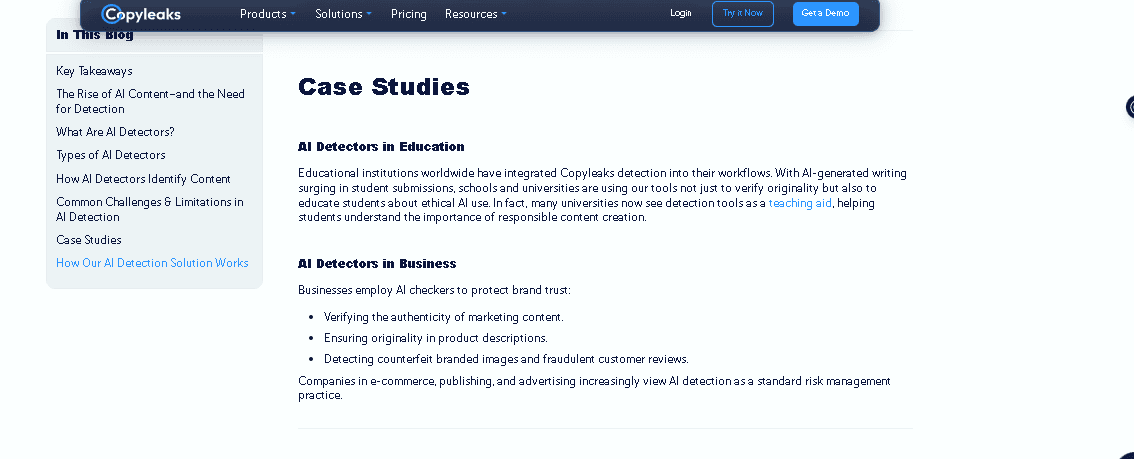
2. Multi-format, multi-language, multi-model coverage
- Supports detection of content generated by major LLMs such as ChatGPT, Gemini, Claude, LLaMA etc.
- AI detection across 30+ languages, and plagiarism detection across 100+ languages. Accepts documents in multiple file formats (PDF, DOC/DOCX, TXT, HTML) and even code file types.

3. Transparent detection & “why” reporting
- A standout feature: “AI Logic” system that doesn’t just give a “yes/no” score, but shows which phrases triggered suspicion (AI phrases), and whether there’s a source match (text appears elsewhere) or pattern recognition.
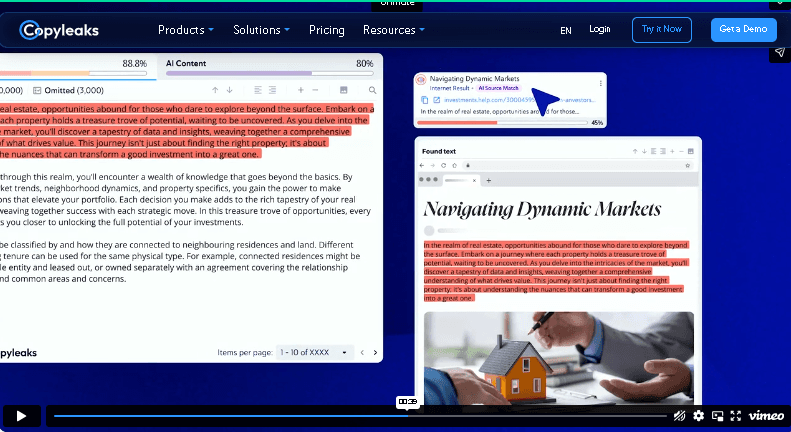
- This transparency helps reviewers, instructors or compliance officers know why a snippet was flagged and make more informed decisions.
4. Workflow & integration ready
- Browser extensions and Google Docs add-ons make detection possible inside regular writing workflows.
- LMS (Canvas, Moodle, Blackboard etc) and API access let you embed detection into your platform—especially useful for institutions or agencies. RushTechHub+1
- Batch processing and enterprise scanning means you can process many documents at once, or automate checks.

5. Combined AI-+-plagiarism detection
- It’s not just about detecting content a machine wrote; it also detects content that has been copied, paraphrased, translated, or otherwise reused without attribution.

- Useful especially for marketing agencies or publishers worried about duplicate content or copyright risk.
Key Features — What You Get
Here are notable features broken down for practical usage:
- Full text/AI probability scoring: The system outputs a confidence score indicating how likely the text is AI-generated vs human.

- Sentence/section-level breakdowns: It highlights individual sentences or phrases flagged as AI-like, so you can review and revise.
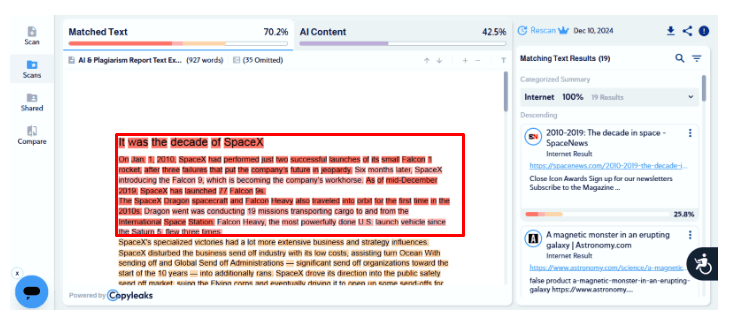
- AI Phrases identification: The system identifies phrases that appear frequently in AI-generated writing and flags them.

- AI Source Match detection: Checks if content overlaps or matches AI-generated text already published or known in their data sets.
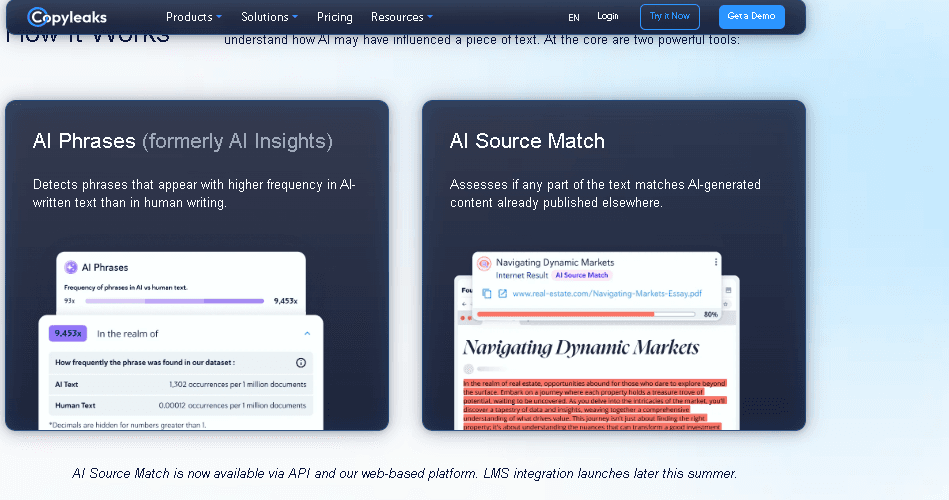
- Paraphrase and translation detection: The tool can detect when text has been paraphrased from another language or adapted from another version—helpful for multilingual or international content.
- Multi-file, multi-format uploads: Supports more than just pasted text — you can upload docs, PDFs, code files, even URLs.

- Batch processing & scale: Good for institutions or large content teams who need to scan many documents at once.
- Browser extension and in-workflow tools: You don’t have to leave your writing environment — use extension or add-on to check content immediately.

- Audit reports & dashboards: Store results, view historical trends, track suspicious usage of AI across teams or students.
- Security & compliance features: Data encryption, secure storage, privacy controls, compliance frameworks (GDPR/SOC).

Practical Guidance — How & When to Use It
For Educators:
- Integrate Copyleaks into your LMS to automatically scan student submissions for AI-written text and plagiarised sections.

- Use the flagged sentences + AI Phrases guidance to open a learning conversation: “Here are the parts that triggered detection — can you describe how you wrote them?”
- When you see high “AI” probability, don’t jump to penalize right away — use the breakdown as a starting point for discussion.
For Content Teams & Marketers:
- Before publishing blogs or social posts, run them through Copyleaks to ensure they don’t read “too AI-like” (which may affect SEO or user trust).
- If you use generative AI for brainstorming, apply Copyleaks after revision to ensure the final output doesn’t retain mechanical patterns or repetitive phrasing.
- Use batch scanning to check entire libraries of content for reuse, translation-paraphrase, or hidden AI-influence.
For Compliance / Legal / IP Teams:
- Use the audit logs and reports to document originality for legal/copyright protection — especially when claims involve reused or AI-generated content.
- Monitor usage of generative AI tools in your organization: “Which parts of our corpus are human-written vs AI-augmented?”
- Use the API integration to scan training data, large uploads or repositories for unauthorized AI-generated or reprocessed content.
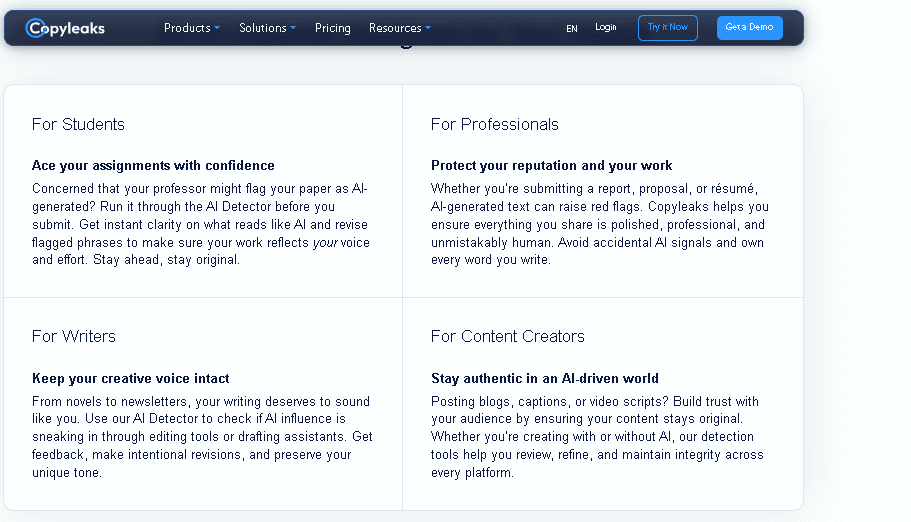
Best Practices:
- Use full documents rather than tiny snippets for greater reliability (detectors perform better with more context).
- Combine detection with human review — flagged text is a signal, not a verdict.
- If flagged content appears, revise: adjust phrasing, vary sentence structure, inject more personal style or domain-specific detail. Then re-scan.
- Keep track of detection trends: e.g., “Which students consistently have high AI percentages?” or “Which writers push content through AI and avoid detection?”
Use multilingual scanning if your content is translated or involves multiple languages — Copyleaks supports 30+ languages for detection.
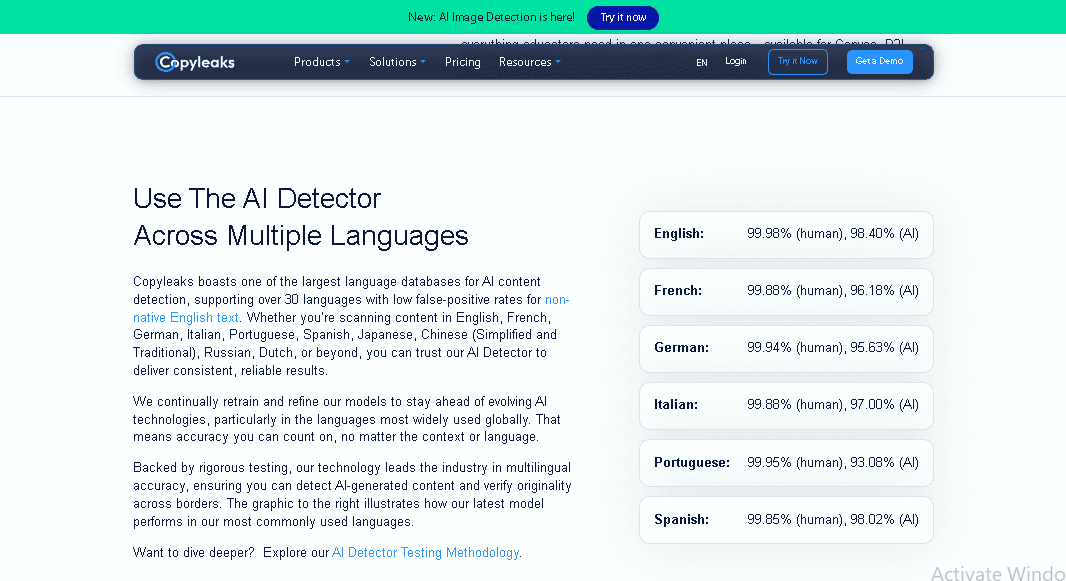
Limitations & What to Be Aware Of
- Even with high accuracy claims, no tool is perfect. A recent study noted that detectors (including Copyleaks) struggle when AI-generated text is heavily human-revised.

- False positives can occur, especially with highly formal human writing, or when text uses many technical terms and sentence structures that mimic AI patterns. One user noted personal writing flagged as 100% AI.

- Very short text samples (<300 words) may yield unreliable scores. The detector itself notes the need for sufficient length.

- Advanced human “AI-human hybrids” (text started by AI then heavily human edited) may evade detection or be ambiguous.
- Premium features (batch uploads, APIs, languages) add cost and may be overkill for casual use.
- Detection is a tool not a final judgement. If the consequences are serious (academic sanctions, legal actions), you should use the detector plus policy, human oversight, documentation.
Pricing & Plans
Here’s how Copyleaks structures pricing based on publicly available info:
- Personal Plan: ~$13.99/month (billed annually) — AI detection + plagiarism checks for individuals.
- Pro Plan: ~$74.99/month (billed annually) — larger volumes, site-wide scanning, analytics, team use.
- Enterprise / LMS / API: Custom pricing for large institutions, bulk scanning, integrations. (Always check the vendor site for latest pricing and terms.)

5. Originality AI
Originality AI is an AI-text detector built for editors, publishers, agencies, and educators. It emphasizes publish-grade detection, offers a Google Docs writing-replay extension to prove authorship, and publishes regular accuracy studies.

Why It Stands Out
1. Proof, not just a score — “watch the writing” The Chrome extension lets you replay how a Google Doc was written (character/word-by-word), giving reviewers evidence of human authorship (or copy-paste). This is uniquely useful when a raw probability score isn’t enough for a decision.

2. Frequent, public accuracy studies Originality.ai regularly publishes methodology and third-party round-ups claiming top accuracy on non-adversarial benchmarks and across multiple model families (OpenAI, Anthropic, Meta, etc.). Treat any “99%” headline carefully, but their cadence of sharing benchmarks is a plus in a fast-moving space.
3. Tunable models by use-case You can pick stricter vs. low-false-positive profiles (e.g., Turbo for zero-tolerance, Lite to minimize false positives, Academic for school use), which helps align detection to policy.

4. Multilingual detection Supports 30+ languages for AI detection (useful for international teams and campuses).

Practical Guidance — How to get reliable results
- Favor longer samples. All detectors need context; aim for a few hundred words+ before trusting a score. Originality
- Use the writing-replay when stakes are high. Scores can be debated; process evidence changes the conversation. Originality
- Pick the right model profile.
- Lite: when you allow light AI assistance and want to reduce false positives.
- Turbo: when your policy is zero AI in deliverables.
- Academic: when reviewing essays and papers. Originality
- Re-scan after edits. If a passage is flagged, revise for specificity and stylistic variation, then re-check to confirm improvements. (Common to all detectors.)
- Document decisions. Save/share the report when outcomes matter (grade, contract, publication). Chrome Web Store
Limitations — What to be careful of
- False positives exist. Independent testing (e.g., Scribbr) reported higher-than-average false positives at times; use the score as a signal, not a verdict — and lean on the writing-replay for adjudication. Scribbr
- Hybrid, heavily edited AI text is hard for everyone. In mixed human/AI drafts, results vary across tools; consider cross-checking if the call is consequential. Tom's Guide
- Short snippets are unreliable. Very short inputs increase ambiguity; analyze full sections or entire documents. Originality
Pricing & Plans (AI detection access)
- Pay-as-you-go: $30 one-time for 3,000 credits (credits = 100 words each; 2-year expiry). Good for ad-hoc checks.
- Pro (monthly): $12.95/mo (2,000 credits per month; file uploads, site scans, team basics).
- Enterprise: $136.58/mo (teams, priority support, API, longer history). Originality.
Tip: If your average piece is ~1,000 words, 2,000 credits ≈ 20 AI scans/month; plan accordingly.
Best for
- Editors & publishers needing pre-publication AI checks and an audit trail. Originality
- Agencies & content teams enforcing “AI-assist ok / final must be human” policies — plus proof via writing-replay. Originality
- Educators who want stronger context than a score when discussing potential AI use with students.

6. Turnitin
Turnitin’s AI detection feature is specifically designed for institutions (universities, colleges, K-12) to help educators identify content generated by large language models (LLMs) such as ChatGPT. It combines Turnitin’s history of similarity/plagiarism detection with new pattern-analysis for AI writing. Bestcolleges.com+2Center for the Advancement of Teaching+2

Why Use It / Why It Stands Out
- Academic-first design: Turnitin has decades of data on student writing patterns. Their AI detector models are trained on student-written text plus known AI-generated text — giving a domain advantage.

- Seamless integration into educator workflows: The AI detection result appears inside the familiar Similarity Report and LMS workflows instructors already use. No separate tool to master.
- High claimed accuracy: Turnitin claims up to ~98% accuracy in controlled conditions assessing AI vs human writing.
- Focus on fairness and bias: Turnitin has published that for submissions longer than 300 words, false positive rates for non-native English writers were not statistically different from native writers.

- Large scale usage: By April 2024, more than 200 million papers were scanned, with approx. 11% flagged as having at least 20% AI-writing content.
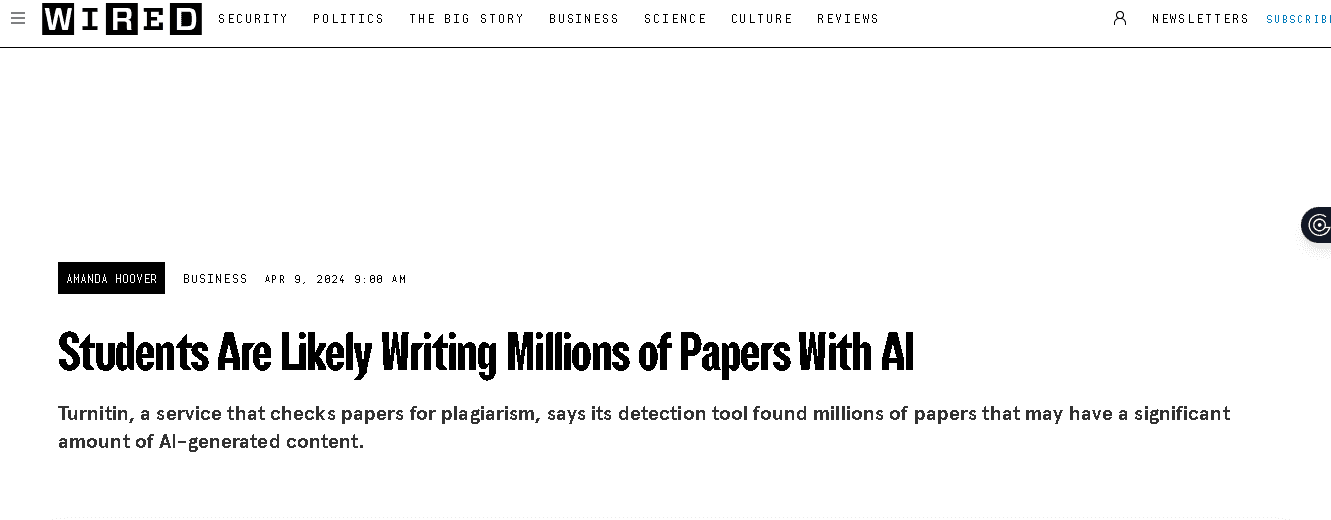
Key Features — What You Get
1. AI Writing Likelihood Score
- Each submission receives a percentage indicating the probability that it contains AI-generated text.

- Score is based on linguistic features such as next-word probability, sentence variation (burstiness), and pattern analysis.
2. Sentence/Segment Highlights
- The system highlights specific sentences or portions of the submission that most closely match AI-style writing patterns.
- Helps educators zoom into “why” a score is high rather than just seeing a number.
2. Minimal Human Bias Design
- Training datasets include a mix of native and non-native English student writing to reduce unfair bias. Turnitin reports no statistically significant bias for non-native writers (for submissions ≥300 words).
3. Policy-Aligned Models
- The detector is designed with education policy in mind: for example, rather than maximising true positives at all cost, Turnitin has indicated it will “miss” some AI writing to keep false positives very low (<1%).
- This aligns with academic fairness concerns.
4. Workflow Integration & Scale
- Built into LMS/submission portals: Canvas, Moodle, Blackboard, etc.
- Processing volume: capable of tens/hundreds of millions of submissions at institutional scale.
- Onboarding/licensing as part of institution’s Turnitin service, not individual subscription.
5. Educator Guidance & Transparency
- Turnitin provides guidance to instructors on how to interpret results (score + highlights) rather than relying solely on detection output.
Practical Advice — How to Use It Effectively
- Use it as a flag, not a verdict. A high AI-score suggests possible AI use, but should trigger a conversation, review of drafts, or instructor follow-up rather than immediate sanction.
- Review highlighted sections. The real value lies in seeing which sentences raised suspicion. Ask: Is it consistent with the student’s writing voice? Are citations and reasoning present?
- Require draft submissions or revision history. If students submit drafts or use revision tools, you can compare style shifts and detect abrupt changes that may align with AI use.
- Educate students about policy up front. Clarify what level or type of AI assistance is permitted, what must be cited, and how human editing plays a role.
- Use long-form text, avoid relying on short samples. The detector is designed for longer prose (e.g., 300+ words); very short responses increase uncertainty.
- Maintain fairness across all students. Ensure interpretation does not disproportionately penalize non-native speakers or students with different writing styles; rely on human review of flagged content.
- Keep audit trails. Save reports, highlight sections, and document follow-up conversations. Especially important in cases of contested results.
Limitations & What to Be Aware Of
- Can still miss AI-generated text. When AI output is heavily edited, embedded in human text, or mixed, detection becomes less reliable. For example, a study found Turnitin correctly labelled 91% of experimental submissions, but those submissions still averaged only ~55% AI-content detected.

- False positives remain a concern. Very formal or highly polished prose may resemble AI style patterns and be flagged incorrectly. One institution disabled the tool citing concerns about reliability.
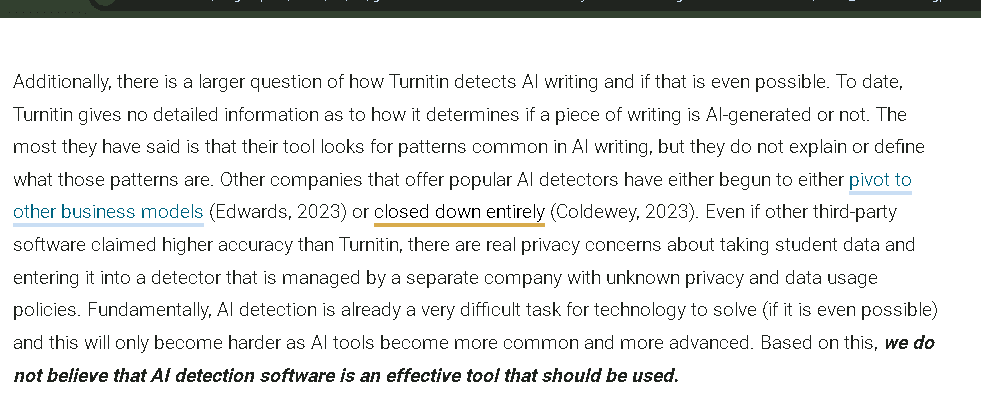
- Lack of granular public transparency. While Turnitin shares claims of accuracy, many parameters (exact thresholds, model updates) remain proprietary — making educator interpretation essential.
- Short texts, lists, bullet points less reliable. The detector is tuned for long-form prose; forms, responses, short answers may produce unreliable read-outs.
Best For & Use-Cases
✅ Universities & colleges that already use Turnitin for plagiarism and want a unified AI-writing detection solution.
✅ K-12 institutions with formal essay submissions where policy prohibits uncovered AI use.
✅ Programs where equity and auditability matter, and you need to document detection + review + decision steps.
Not ideal for:
- Freelancers or content creators outside academia (Turnitin is institution-licensed, not individual direct purchase)
- Cases where you need a lightweight, standalone detector for short blog posts or marketing content
AISEO AI & Humanize AI Text: The Best Companion to AI Detectors
Detection is only half the equation. Once AI-generated content is flagged, you need a way to make it sound human, authentic, and natural. That’s where AISEO AI Humanizer and Humanize AI Text— comes in.
These tools work alongside any detector (GPTZero, Copyleaks, or Turnitin) to rewrite AI-generated sentences in a more organic and human-like style. They use advanced rephrasing and tone modeling to preserve meaning while removing detectable AI patterns.
Unlike simple paraphrasers, AISEO and Humanize AI focus on:
- Preserving intent and context
- Adding emotional nuance
- Bypassing AI detectors effectively
For content creators, it’s the perfect post-detection tool: detect with GPTZero or Copyleaks, then humanize with AISEO AI Text for polished, undetectable writing.
Tips for Using AI Detectors Effectively
1. Scan early when the writing is still rough
AI detectors are more accurate before heavy editing smooths everything into a predictable structure. Running an early scan helps identify robotic, repetitive, or overly polished phrasing while you still have room to adjust. Fixing AI traits early prevents full drafts from being flagged later and saves hours of rewrites.
2. Use more than one detector to validate results
Every platform has different strengths and false positive patterns. If one detector flags your text aggressively while two others say it’s mostly human, there’s a strong chance you’re seeing an accuracy gap in the tool — not a real authenticity issue. Cross-checking protects you from unfair classification.
3. Analyze shorter chunks instead of full documents
AI detectors often show mixed results when scanning large essays, long blog posts, or articles with multiple writing styles. Running section-by-section scans pinpoints specific paragraphs where AI patterns are detected. This makes revision easier and prevents unnecessary rewriting of unaffected sections.
4. Rewrite flagged parts with a more human voice
Add personal thinking, first-hand experience, argument variance, and emotional tone. Humans naturally mix sentence lengths, ask questions, reference real events, and break rules occasionally. These traits dramatically boost “human score.” If needed, tools like AISEO AI Humanizer can help refine the tone without losing meaning.
5. Do not treat detection scores as final judgment
Detectors measure probability — not intent or creativity. If your own, original writing is flagged, rely on your reasoning, drafts, and revision history to defend authenticity. Let detectors guide improvements, not dictate trust.
6. Keep edits, drafts, and brainstorming logs
Especially for students and professionals subject to review, having visible proof of how your writing evolved protects against false accusations. Screenshots and version history can show genuine authorship.
7. Stay aware of model updates
Detectors evolve every few months, just like the AI they monitor. A clean result today may be flagged differently in the future. Periodic re-checks help maintain compliance for long-term published content.
AI detectors are best used as supportive tools that help refine originality — not as strict verdicts on your work.

Ethical Considerations When Detecting and Humanizing AI Writing
1. Intent defines whether the use of AI is acceptable or harmful
AI-powered brainstorming or rewriting to improve clarity is appropriate, but presenting fully automated writing as original human work — especially in schools or journalism — crosses ethical boundaries. Writers should regularly ask themselves why they’re using AI.
2. Transparency builds credibility in academic and professional settings
Many institutions now allow AI, but require disclosure. Clearly stating where AI contributed maintains fairness and avoids accusations of misconduct. Deception erodes trust much faster than AI improves productivity.
3. Humanizers must be used responsibly
Tools that rewrite and disguise AI text — including advanced humanizers — should be used to elevate tone and clarity, not to hide unethical reliance on automation. The purpose should be honest communication, not bypassing academic or workplace integrity policies.
4. AI-written content must be fact-checked
AI often fabricates citations, statistics, or expert claims. Publishing unchecked information risks reputational damage, academic penalties, or legal consequences. The human is always responsible for truth — the AI is not.
5. Originality and authorship become blurred when relying too heavily on machine-generated content
Who deserves credit for ideas? What qualifies as plagiarism if the source is an algorithm trained on millions of human writers? Writers should ensure their unique perspective remains central.
6. Bias and equity concerns must be recognized
AI models are trained on selective data and may unintentionally exclude certain dialects, cultures, and identities. Human revision ensures better representation and ethical communication.
7. Industry rules differ, and writers must adapt accordingly
Journalism, medicine, legal documentation, education, and SEO each have distinct expectations regarding AI involvement. Understanding contextual standards prevents unintended violations of policy.
Ethical AI writing is about clarity, honesty, verification, and maintaining the human role in communication — not eliminating automation, but setting fair boundaries around it.

Final Thoughts
AI detection has quickly become essential for anyone who creates, publishes, or evaluates content. As artificial intelligence tools evolve, so do the systems designed to verify authenticity. Whether you’re a student safeguarding academic integrity, a marketer protecting brand trust, or a publisher defending SEO performance, choosing the right AI detector can make all the difference.
Each tool reviewed in this guide brings unique strengths — from Turnitin’s academic focus to Humanize AI’s practical rewrite capabilities. The smartest approach is a balanced one: detect early, verify often, and refine content to ensure your writing remains accurate, human, and original.
Frequently Asked Questions
1. What is the most accurate AI text detector in 2025?
Copyleaks and Originality.AI currently top the list for enterprise accuracy, while GPTZero remains best for academia.
2. Can AI detectors guarantee 100% accuracy?
No. Even the best detectors occasionally mislabel text due to stylistic overlaps between human and AI writing.
3. How do AI detectors identify machine-written text?
They analyze linguistic patterns, sentence predictability, and perplexity — indicators of algorithmic generation.
4. Is it ethical to rewrite AI text using tools like AISEO AI Humanizer Text?
Yes, as long as it’s used to enhance readability or align tone — not to misrepresent authorship.
5. Can AI detectors recognize rephrased content?
Advanced detectors like Copyleaks and Turnitin can sometimes catch rephrased AI text, though effective humanizers reduce detectability.
6. Do free AI detectors work well?
Free tools like GPTZero and Content at Scale offer good initial checks, but paid platforms provide deeper analytics.
7. Will AI detectors stay relevant as AI models improve?
Absolutely — they’ll evolve in parallel, using newer algorithms and large datasets to adapt to emerging writing styles.

About Dilyar Buzan
Founder & CEO at AISEO
Artificial Intelligence - University of Amsterdam
LLM engineer
